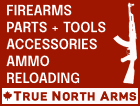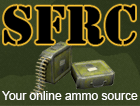Looking around online a common piece of advice I see for new shooters is to start with .22 rimfire to prevent yourself from developing a flinch. Is there an obvious natural progression/grouping of the popular rounds out there for a beginner to work their way through? Also is there an easy way to determine how much a given round is going to kick relative to other rounds out of a similar firearm by looking at its datasheet?
|









 Reply With Quote
Reply With Quote









